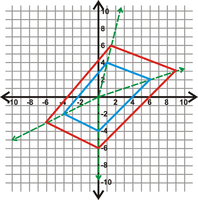You are using an out of date browser. It may not display this or other websites correctly.
You should upgrade or use an alternative browser.
You should upgrade or use an alternative browser.
Enlarge a geometric shape
- Thread starter Jame
- Start date
Dr.Peterson
Elite Member
- Joined
- Nov 12, 2017
- Messages
- 16,605
We can help you better if we know what you have learned. You might have been taught a specific transformation that does this; or you may be expected to invent it. In the latter case, do you see any proportions here? Pick one vertex of the blue figure, and think about how the corresponding vertex of the red figure is related to it.
We can help you better if we know what you have learned. You might have been taught a specific transformation that does this; or you may be expected to invent it. In the latter case, do you see any proportions here? Pick one vertex of the blue figure, and think about how the corresponding vertex of the red figure is related to it.
Thank you for the fast reply.
Each x, y coordinate of the vertices of the blue shape was multiplied by a certain factor. But how do you do that if one of the blue shape's verices had a coordination of (0, 0), do we just substarct the factor? Will it keep the same proportion (sorry for any typo, english isn't my first language.)
Dr.Peterson
Elite Member
- Joined
- Nov 12, 2017
- Messages
- 16,605
Thank you for the fast reply.
Each x, y coordinate of the vertices of the blue shape was multiplied by a certain factor. But how do you do that if one of the blue shape's vertices had coordinates of (0, 0), do we just subtract the factor? Will it keep the same proportion (sorry for any typo, english isn't my first language.)
If a vertex were at (0, 0), then after the transformation multiplying coordinates by some k, the image of the vertex would be (k*0, k*0) = (0, 0). This transformation leaves the center of dilation fixed You wouldn't do anything differently.
But, of course, that is not true in this problem, so I take it that you have solved it?
Yes, thank you very much for your help.If a vertex were at (0, 0), then after the transformation multiplying coordinates by some k, the image of the vertex would be (k*0, k*0) = (0, 0). This transformation leaves the center of dilation fixed You wouldn't do anything differently.
But, of course, that is not true in this problem, so I take it that you have solved it?

